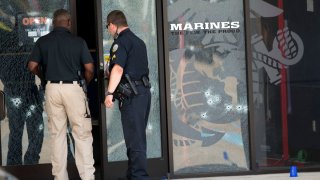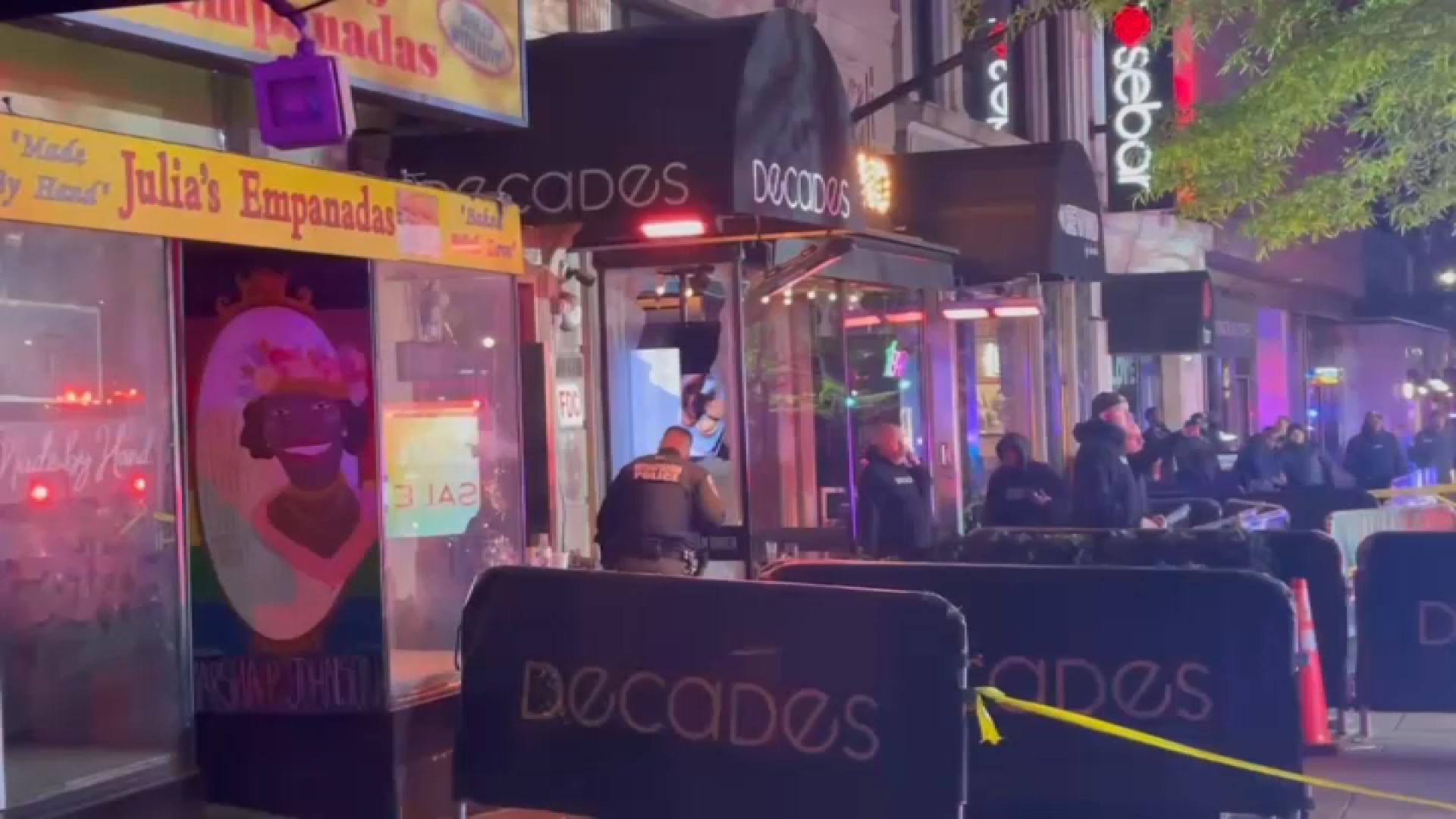The history of gun attacks at military facilities in the United States in many ways reflects those in society at large: they run the gamut from domestic attacks and drunken fights to politically motivated massacres, including the 2009 killing of 13 at Fort Hood, Texas. But unlike the rest of society, the people who live and work on these posts often suffer from stresses caused by the trauma of war and serving in the armed forces. They often end in suicide.
Here is a brief recent history of shootings on the grounds of military installations.
December 2019: Three people were killed and multiple others injured, including two sheriff's deputies, in a shooting at Naval Air Station Pensacola in Florida. The shooter also was killed, according to the Escambia County Sheriff's Office and the U.S. Navy.
December 2019: A Navy sailor shot three Department of Defense civilian workers in the Pearl Harbor Navy Shipyard, killing two of them before killing himself.
April 2019: A female sailor was wounded in a "domestic" shooting in a Virginia Beach, Virginia, base parking lot and security fatally shot the shooter, a male sailor. The shooting took place in a Strike Fighter Squadron 37 hangar parking lot at Naval Air Station Oceana.
July 2015: A gunman killed four Marines in attacks on a military recruitment center and a Navy and Marines reserve center in Chattanooga, Tennessee. A sailor died two days later from his injuries. A police officer and a Marine recruiter were injured in the violence. The gunman, identified as Muhammad Youssef Abdulazeez, died after a shootout with police. Abdulazeez suffered from depression and drug abuse, his family later told The Associated Press. He also had downloaded audio recordings of Anwar al-Awlaki, the American-Yemeni cleric who was a recruiter for al Qaeda.
April 2014: Violence hit Fort Hood for a second time, when an Iraq War veteran opened fire on the base, killing three and injuring 16 others before committing suicide. Specialist Ivan A. Lopez, 34, shot himself when he was confronted by a police officer. Lopez was being treated for depression, anxiety and other behavior and mental issues, and was being evaluated for PTSD, military officials said.
Local
Washington, D.C., Maryland and Virginia local news, events and information
March 2014: A sailor was killed while trying to stop a gunman attempting to board a ship in Norfolk, Va. Authorities say Petty Officer 2nd Class Mark Mayo, 24, jumped between the civilian shooter and a another sailor, saving her life. The alleged gunman, Jeffrey Savage, was killed by Navy security forces.
September 2013: Twelve people died and four were injured after a government contractor opened fire inside the Navy Yard complex in Washington, D.C., committing one of the worst attacks at a U.S. military installation since the November 2009 killing of 13 at Fort Hood. Gunman Aaron Alexis, who had just recently begun an assignment at the site, was shot and killed by officers. Authorities later said that Alexis, who appeared to target his victims at random, "held a delusional belief that he was being controlled or influenced by extremely low frequency, or ELF, electromagnetic waves.”
June 2013: An Army captain at Joint Base San Antonio-Fort Sam Houston, Texas was allegedly shot and wounded by her common-law husband, Alvin Roundtree at the Army Medical Department Center and School, where she was an instructor. Roundtree is a retired soldier.
April 2013: Lloyd Gibert, a civilian employer at a Fort Knox, Ky. parking lot, was shot to death outside the post's Army Human Resources Command building. A Fort Knox soldier, Marquinta E. Jacobs, was arrested in the killing.
March 2013: Marine Sgt. Eusebrio Lopez, a tactics instructor, shot and killed two colleagues at Marine Corps Base Quantico’s Officer Candidates School in Quantico, Va. before shooting himself to death. The victims were Lance Corporal Sara Castromata, a warehouse clerk, and Corporal Jacob Wooley, a field radio operator.
December 2012: Spc. Marshall D. Drake, a soldier at Joint Base Elmendorf-Richardson in Alaska, shot to death a fellow solder, Pfc. Grant Wise, after a night of heavy drinking. Wise was found dead in Drake's barracks on Christmas morning. Drake was sentenced for 12 years in a military prison.
June 2012: Spc. Ricky Elder killed himself a day after allegedly shooting and killing his battalion commander, Lt. Col. Roy L. Tisdale, during a safety briefing near his unit's headquarters at Fort Bragg, N.C. News reports indicated that Elder faced legal troubles, and had said he'd been diagnosed with dementia.
May 2012: A soldier was shot by a fellow service member after a traffic accident on the grounds of Fort Carson, Colo. The shooting happened after one of the soldiers allegedly lost control of the car he was driving and crashed into the other soldier's home. After a fight, the resident opened fire, hitting the driver twice and himself once.
April 2012: A soldier at Fort Campbell, Ky., Spc. Rico Rawls Jr., allegedly shot and killed his wife, Jessica Rawls, at their home on the Army post, then led police on a highway chase into Georgia. Before his arrest, he shot himself and eventually died.
July 2011: Army Pfc. Naser Abdo, 21, was arrested in Killeen, Texas, near Fort Hood, on warrants out of Fort Campbell, Ky., for being AWOL and possessing obscene material. Abdo, who claimed to be a conscientious objector, later admitted to planning a "massive" attack at a restaurant near the Texas post. After his arrest, the FBI said bomb-making materials were found in his motel room and said he was in possession of a large amount of ammunition, weapons and a bomb in a backpack. The day after his arrest, Abdo shouted "Nidal Hasan, Fort Hood 2009" as he was escorted out of a Texas courtroom. In 2012, Abdo was sentenced to life in prison.
May 2011: Sgt. Jason Seeds, a soldier at Fort Drum, N.Y., allegedly shot his wife during a dispute at their home on the Army post. She lived, and explained later that her husband had suffered from deteriorating mental health since returning home from war.
October and November, 2010: Marine Corps reservist Yonathan Melaku committed a series of drive-by shootings at various military installations in northern Virginia, none of which resulted in anyone getting hurt. When law enforcement agents arrested him, they found bomb making material with him. Melaku was sentenced to 25 years in prison.
November 2009: Maj. Nidal Malik Hasan carried out the largest mass murder at a military installation in American history, opening fire on dozens of unarmed soldiers at a medical deployment center at Fort Hood, Texas. Thirteen were killed and another 32 were wounded. Hasan was sentenced to death.
July 2009: Army Sgt. Ryan Schlack was shot while trying to break up a fight at Fort Hood, Texas. A fellow soldier, Spc. Armano Baca, is serving 20 years in prison for the murder.
June 2009: Abdulhakim Mujahid Muhammad, a self-described Islamic radical, opened fire on a military recruiting center in Little Rock, Ark., killing one Army private, William Long, and wounding another, Quinton Ezeagwula. Muhammad was sentenced to life in prison.
September 2008: A soldier at Ft. Hood, Texas, shot and killed his lieutenant then committed suicide on the balcony of his apartment.
October 1995: Sgt. William J. Kreutzer Jr. went on a shooting spree at Fort Bragg, N.C., killing one officer and wounding 18 soldiers, members of the 82nd Airborne Division, as they participated in morning physical training exercises. He was sentenced to life in prison.
March 1995: Ernest J. Cooper Jr., a civilian Navy worker, shot and wounded two co-workers at Naval Air Systems Command in Arlington, Va. then killed himself. One of the victims, Nils F. ``Fred'' Salvesen, was Cooper's supervisor and the first to be shot. The other, Navy Cmdr. Harry F. Molyneux, was sitting nearby when Cooper turned the gun on him.
June 1994: Airman Dean Mellberg opened fire at the Fairchild Air Force Base hospital outside Spokane, Wash., killing four people and wounding 23 before a security officer killed him.




